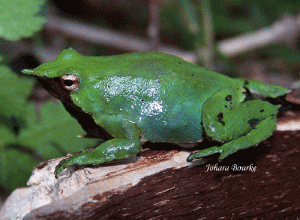 Species name: Rhinoderma darwinii
Species name: Rhinoderma darwinii
Common name: Darwin’s frog (English), Ranita de Darwin (Spanish), Nasenfrösche (German)
Red List status: Vulnerable (http://www.iucnredlist.org/apps/redlist/details/19513/0)
Distribution: Concepción to Palena Province in Chile. In Argentina, it is known from Neuquén and Río Negro provinces.
Habitat: It generally occurs in the leaf-litter of temperate forests (such as Nothofagus); it is also present in forest bogs.
Threats to survival: Habitat destruction (soil use substitution such as: pine-eucalyptus forestry, agriculture, cattle raising; dams and clear cutting), diseases (such as: Chytrid, Bourke et al. 2010) and climate change.
Species Assessment by AArk: Rhinoderma darwinii was assessed at the Chilean Amphibian Conservation Needs Assessment workshop Chile, November 2009. The species has the following conservation requirements:
In Situ Research – A species that for one or more reasons requires further in situ research to be carried out as part of the conservation action for the species. One or more critical pieces of information is not known at this time.
Ex Situ Research – An amphibian species undergoing specific applied research that directly contributes to the conservation of that species, or a related species, in the wild (this would include clearly defined ‘model’ or ‘surrogate’ species).
Conservation Education – A species that is specifically selected for management – primarily in zoos and aquariums – to inspire and increase knowledge in visitors, in order to promote positive behavioural change. For example, when a species is used to raise financial or other support for field conservation projects (this would include clearly defined ‘flagship’ or ‘ambassador’ species).
Reproductive behaviour: Darwin’s frogs have a unique brood system, named neomelia, in which males breed their offspring in their vocal pouch. In Rhinoderma darwinii the offspring live in the vocal pouch and the male releases them as metamorphosed froglets.
Interesting natural history notes: Rhinoderma is characterized by a particular nasal prolongation, small sizes (from 0.4 to 3.2 cm.), a high coloration and design variability similar to leaflet, a bird-like tweet, their individual ventral pattern.
This species was discovered by Charles Darwin (1831) when he was travelling around the word in the Beagle, the exemplar was send to be describe by Duméril and Bibròn (1841), and they thought that the females individuals were the ones that carried the tadpoles. It was not until 1872 that Jimenez de la Espada noticed that the “pregnant” individuals were males, which reared their tadpoles in a vocal pouch. Unfortunately, Darwin’ frogs sister specie (R. rufum) hat not been seen since 1980. And the only other species known with an equally sophisticated brood care system was Rhenobatrachus, an Australian genus which brood their offspring in their stomach (Tyler 1985), but is already extinct (Angulo, 2002).
In situ projects currently underway: Since 2001 the Rhinoderma project started to survey Rhinoderma populations in Chile. Since 2005 the project has surveyed and monitored R. darwinii populations thanks to the support from Chester Zoo, Leipzig Zoo, ZGAP and Reptilia. Additionally, numerous scientists have recentlystarted other in situ projects.
Ex situ programs: In 2009 the Rhinoderma Project established the Concepción’s rearing facility at Concepción University, supported by: Leipzig Zoo, Concepción University, Chester Zoo, ZGAP, Reptilia, Huilo-Huilo and SAG. Up to now, the facility has breed more than thirty froglets. The Santiago’s metropolitan zoo, with support from the Atlanta Botanical Garden recently began to breed Darwin’s frogs at the Santiago’s metropolitan zoo, Chile.
How can I help this species? Promoting in situ conservation and avoiding habitat destruction. Also, you can donate at ZGAP Bank account 54550009, BLZ 62063263.







